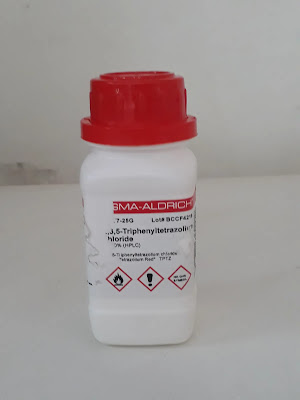Product Identification
The Triphenyl Tetrazolium Chloride SDS of Lab Safety
Hazards Identification
- Acute toxicity: Tetrazolium chloride is considered a low-toxicity material, but it may cause mild skin & eye irritation.
- Chronic toxicity: Long-term exposure to tetrazolium chloride has not been reported to cause any chronic health effects.
- Carcinogenicity: Tetrazolium chloride has not been classified as a carcinogen.
First Aid Measures
- Inhalation: If inhaled, remove to fresh air. If breathing is difficult, give oxygen. If not breathing, give artificial respiration.
- Skin contact: In case of contact, immediately flush the skin with plenty of water.
- Eye contact: In case of contact, immediately flush your eyes with plenty of water for at least 15 minutes.
- Ingestion: If swallowed, do not induce vomiting. Rinse your mouth & drink plenty of water.
Fire-Fighting Measures
- Flash point: Not applicable
- Flammable limits: Not applicable
- Fire extinguishing media: Use water spray, foam, dry chemicals, or carbon dioxide.
Accidental Release Measures
- Personal precautions: Avoid contact with eyes, skin, and clothing.
- Environmental precautions: Prevent products from entering drains.
- Methods for cleaning up: Collect spillage and remove it to a safe place.
Handling & Storage
- Handling: Avoid contact with eyes, skin & clothing.
- Storage: Store in a cool, dry place.
Exposure Controls/Personal Protection
- Respiratory protection: Not normally required.
- Hand protection: Wear appropriate gloves to prevent skin contact.
- Eye protection: Wear appropriate protective eyeglasses or chemical safety goggles.
- Skin & body protection: Wear appropriate protective clothing to prevent skin contact.
Physical & Chemical Properties
- Appearance: White powder.
- Melting point: Not available.
- Boiling point: Not available.
- Solubility: Soluble in water, ethanol & methanol.
- Vapor pressure: Not available.
- pH: Not available.
- Formula: C19H15ClN4.
Stability & Reactivity
- Stability: It is stable under normal conditions.
- Hazardous reactions: None knew.
- Hazardous decomposition products: None knew.

Triphenyl tetrazolium chloride (TTC) or tetrazolium chloride is a chemical reagent that is commonly used as a redox indicator in the detection of viable cells & in the analysis of mitochondrial function.
Conclusion
One must follow Triphenyl Tetrazolium Chloride SDS. Tetrazolium chloride is a widely used reagent in the detection of viable cells & in the analysis of mitochondrial function. It is considered a low-toxicity material, but it may cause mild skin and eye irritation. Proper protective measures, such as wearing gloves and goggles, and avoiding skin & eye contact, should be taken when handling tetrazolium chloride. In case of accidental exposure, appropriate first aid measures should be taken immediately. It should be stored in a cool & dry place. If you have any doubts or concerns, please consult a qualified professional.
